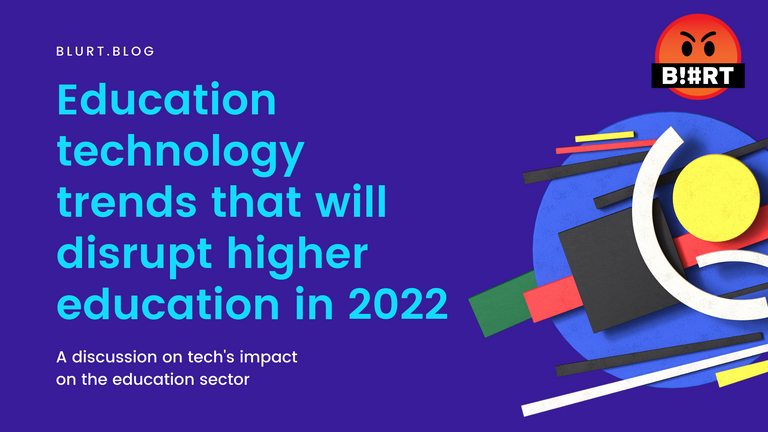
Higher education institutions would accelerate the adoption of cloud-based technologies for student relationship management (CRM), learning management systems (LMS), assessment management, etc.
Preference would be for niche applications having seamless integration capability with other applications. If you are building EdTech applications then it become essential to have components to integrate your application with other applications.
Here is the list of Technologies that would shape Higher Education in 2022.
- Video-Based Learning: Video is becoming a de facto medium for learning purpose. Instead of reading long paragraphs, students would also prefer to watch videos for better understanding and knowledge retention process.
There are various types of videos you can prepare for higher education which are as listed below.
•Educational / Topic Based Videos
•Technology-based videos with screenshots and images along with a description
•Classroom Based Videos
Blockchain: blockchain for education. Blockchain is technology acting as a framework for ever-growing cryptocurrency. Blockchain is providing great collaboration and secure data exchange opportunities for the organizations as well as individuals. Security protocols followed in blockchain are unique and difficult to hack.
Online Assessment Techniques: AI-driven assessments can help institutes to get a holistic analysis of student performance in a particular exam. Using machine learning and artificial intelligence-driven algorithms, theory answers written by the students can also be evaluated by the software. It can compare the answers with model answers for better accuracy prediction
Self Paced Learning: When it comes to learning activities, every student has some strengths and some weaknesses. A student may like to subject which he/she will study often. This way, that particular becomes his/her strength. In the coming year, higher education institutions are likely to invest a significant budget on online learning instead of spending on building traditional classroom-based infrastructure.
Artificial Intelligence (AI): AI is likely to dominate a lot of headlines in the coming year. It has found millions of use cases across multiple sectors. One of the commonly used features is of facial recognition. It has been proving helpful to secure campus infrastructure from unauthorized access for any big or small organization. There are many ways in which AI based auto proctoring can be used to invigilate online exams. Some of the features powered by AI
Internet of Things (IoT): Internet of Things refers to small objects which can be connected through internet to transfer or collect data. These objects can work on their own without human intervention. IoT is helping many sectors for automation and control. It is likely to be used in higher education as well. Many use cases like face detection, monitoring student vehicles, analysis of machine performance, etc. can be done using IoT.
Summary:
Brands of higher education institution would be recognized due to technology implementations and investment in traditional physical infrastructure may come second to technology.
Source: https://blog.epravesh.com/education-technology-trends-2022/
** Your post has been upvoted (11.20 %) **
Curation Trail Registration is Open!
Curation Trail Here
Delegate more BP for better Upvote + Daily BLURT 😉
Delegate BP Here
Thank you 🙂 @tomoyan
https://blurtblock.herokuapp.com/blurt/upvote
Hi @yateghteghs, this work is plagarized.
Plagiarism means copying someone's work. Even if you add the source, it is still considered as plagiarism. But assuming you learnt something from someone's work, and then explain them in your own words, it is not plagiarism. You can even include your source as reference.
Definitions:
Plagiarism is stealing someone else’s work or ideas and claiming it as your own. It is a serious offense and can have serious consequences. Even when the content you are copying is not under copyright, you still must cite your sources.
Paraphrasing is to restate a concept with your own words. This is far more than just switching around a word or two; it is a complete restatement of the original content.
Citing means to give acknowledgment, or credit to, the person who actually created the content you’re using.
With these definitions, it is easy to identify plagiarism – it occurs any time someone tries to take credit for someone else’s work, thoughts or content.
I didn't take credit or claim ownership and I gave references to the source.
However, thanks for teaching me more today.
You are welcome, @yateghteghs.
It's considered plagarism because you want to earn from it. Have you consider YouTube music videos that gets taken down? Even though you cite the singer as long as your purpose is to earn from it, it is considered plagiarism. If you have canceled reward on the post, then your point would have been valid.
Citing means, you copy someone's work just to make emphasis on your own point, and at the end make reference to the person. For instance when a person in a middle of his work says "Abraham Lincoln once said". Cited works normally don't take up to 25% of a your total work, some publishes insist on 20 for journals. But the "citation" rating of yours was almost 90, that's truly why it wasn't curated.
We learn everyday. You can still post an original work by you and be upvoted by EPISTEM. Thanks for understanding.
Congratulations, your post has been upvoted by @r2cornell, which is the curating account for @R2cornell's Discord Community.